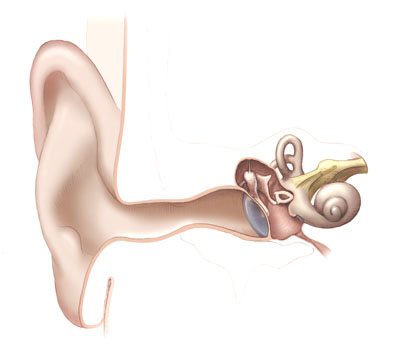Once the sound waves travel into the ear canal, they vibrate the tympanic membrane, commonly called theeardrum. The eardrum is a thin, cone-shaped piece of skin, about 10 millimeters (0.4 inches) wide. It is positioned between the ear canal and the middle ear. The middle ear is connected to the throat via the eustachian tube. Since air from the atmosphere flows in from your outer ear as well as your mouth, the air pressure on both sides of the eardrum remains equal. This pressure balance lets your eardrum move freely back and forth
The eardrum is rigid, and very sensitive. Even the slightest air-pressure fluctuations will move it back and forth. It is attached to the tensor tympani muscle, which constantly pulls it inward. This keeps the entire membrane taut so it will vibrate no matter which part of it is hit by a sound wave.

Ear illustration courtesy NIDCD
Normal ear anatomy
This tiny flap of skin acts just like the diaphragm in a microphone. The compressions and rarefactions of sound waves push the drum back and forth. Higher-pitch sound waves move the drum more rapidly, and louder sound moves the drum a greater distance.
The eardrum can also serve to protect the inner ear from prolonged exposure to loud, low-pitch noises. When the brain receives a signal that indicates this sort of noise, a reflex occurs at the eardrum. The tensor tympani muscle and the
In addition to protecting the ear, this reflex helps you concentrate your hearing. It masks loud, low-pitch background noise so you can focus on higher-pitch sounds. Among other things, this helps you carry on a conversation when you're in a very noisy environment, like a rock concert. The reflex also kicks in whenever you start talking -- otherwise, the sound of your own voice would drown out a lot of the other sounds around you.
The eardrum is the entire sensory element in your ear. As we'll see in the coming sections, the rest of the ear serves only to pass along the information gathered at the eardrum.
(Source: How stuff works?)


